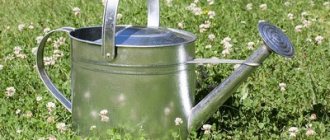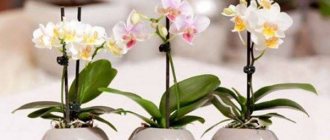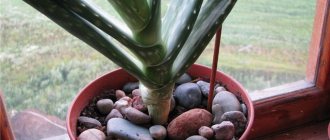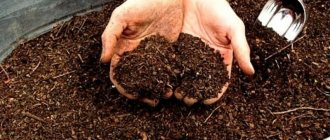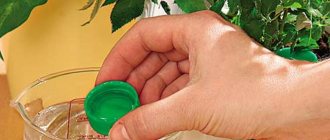A solution of potassium manganese is a substance that disinfects the soil and stimulates the growth of orchids.
But in order for everything to grow well, you must be able to correctly create a solution and carry out the necessary processing . If done incorrectly, you can burn the plant's root system. Next, we will look at whether it is possible to treat an orchid with potassium permanganate and how to do it correctly.
How to identify bad roots in an orchid?
What kind of roots should a healthy orchid have?
Photo of the root system
- Growing tip.
- Have a light green velamen color.
- Be elastic and hold its shape when pressed with two fingers.
- Dark and having a putrid odor, this is a sign that the root system is unhealthy and requires resuscitation.
Interesting materials:
How many cores are there in i3 9100f? How many cores are there in i5 9400f? How many cores are there in i7 9700k? How many cores does the i9 9900k have? How many cores does the Intel Core i5 9400f have? How many cores does Xiaomi Note 4 have? How long does EMS delivery take? How long does it take for an international transfer? How long does it take to transfer from an Alfa Bank account to a Sberbank account? How long does a swift transfer take?
Preparation of the solution
It's easy enough:
- carefully open the bottle of dry potassium permanganate over a newspaper;
- hands must be dry;
- With the tip of a dry knife, literally take a couple of granules and dilute them in warm water ;
- the granules must dissolve completely , since those remaining undissolved will burn the roots or leaves of the plant;
- if the solution turns out to be too pink, then it is diluted to the desired concentration with warm boiled water.
Potassium permanganate granules should completely dissolve in water.
IMPORTANT! Carry out all manipulations over newspaper or oilcloth and do everything as carefully as possible so as not to spill the entire bottle.
Nuances
If you are in doubt about whether you need to water, it is better to wait. It is easier for an orchid to endure short-term drought than to cope with the consequences of overwatering. Monitoring the condition of the root system is not difficult. Phalaenopsis plants are sold and grown in clear plastic pots. This makes it possible to timely assess the condition of the roots.
Watering is required in the following cases:
- gray roots;
- the soil inside the pot is completely dry;
- More than 10 days have passed since the last watering.
How to bathe a flower?
During the flowering period, it is better not to put the orchid in the shower. Water that gets on buds and flowers can lead to the following consequences:
- their falling off;
- the settling of an unsightly whitish coating on the flowers;
- rotting of buds (if water gets inside).
A contraindication to this procedure during the tender period would be water getting on the peduncle. If you can avoid this by carefully moistening only the soil, then go ahead. But be sure to use cool water. Flowering orchids are very sensitive to warm water. It won't be useful to them.
To reduce the risk, it is better to avoid showering. Basin baths work well. They are better at preventing parts that should remain dry from getting wet. You can water it from a watering can.
Interesting! Orchids grow in tropical forests, parasitic on trees. They are watered by heavy downpours followed by drought. But rainwater does not affect flowers as aggressively as tap water.
How to preserve a plant during the holidays?
To support plants during absence, you can use several methods:
- Install an automatic watering system. The method is expensive. It is unlikely that anyone will purchase it specifically for orchids. But if such a system exists, this is the most convenient option.
- It is good to water the flower using one of the traditional methods and let the water drain. Place the pot inside a large, slotted plastic bag. This will delay the evaporation of moisture. The holes in the bag will create ventilation to prevent rotting and mold.
- Place a container of water next to the pot that is taller than the pot. Place the end of the tourniquet into it and insert the other end into the pot. Water, soaking the rope, will flow into the ground. The intensity of such watering will depend on the thickness of the rope.
- Make a large tray with drainage and pour water. It should not reach the bottom of the pot.
- Place pots in windows with minimal sun exposure and lower air temperatures.
How to water it so that the orchid changes color and turns blue?
Blue flowers are not found in nature. They are processed until they are cut. White varieties are often used for this purpose. It is modified by adding special dyes.
Before deciding on such a procedure, here are some things to think about:
- in industrial conditions, this is done by trained flower growers;
- with such intervention, the plant experiences stress;
- death of the exotic is possible.
An incorrect procedure can ruin the flowers. They will not necessarily color evenly. The body of the plant may also be damaged. The chemical used for dyeing is foreign to him.
Attention! Painting flowers at home is very risky.
Flowers are painted by adding a solution with pigment during watering or by injection into the peduncle. The second option is considered safer, since it does not affect all parts of the plant. After staining, the orchids will remain blue for a while and then begin to fade. The effect will not be permanent.
Watering methods at home with photos
To water orchids, methods are used that allow the soil to be well wetted. If there is no soil, increase the frequency of procedures.
Common watering methods:
- immersion;
- top watering;
- warm shower;
- spraying the roots.
High-quality watering requires an even distribution of water inside the pot. On average, this takes 3 – 15 minutes.
Dive
The most common watering method. To carry out the procedure, you need a deep utility basin and suitable water. This will be water purified from chemical impurities. They may be too aggressive for the flower to absorb or leave visual defects on the leaves. For example, excessively chlorinated water will not work. A high content of mineral salts will also not be beneficial, since the degree of solubility of substances decreases.
Attention! To make water softer and cleaner, use boiling or filtering using a standard household filter. Distillation is not necessary. Orchids tolerate moderate levels of impurities. Therefore, if you only have relatively high quality tap water, you can use that.
Procedure steps:
- Take cool or slightly warm water.
- Submerge the pot so that it rises half a centimeter above it.
- Let stand for ten minutes to half an hour so that the roots and soil absorb enough moisture.
- remove the pot from the basin and allow the excess to drain.
Top watering
It is rarely used, as it does not always give the desired result. Water quickly drains through thin soil, and the pieces of bark do not have time to get wet enough. The advantages of such watering: the leaf sinuses are not affected, and there is no need to prepare a large amount of filtered water. But there is a high probability that the hydration will be uneven.
Proper watering of the soil from above includes the following points:
- water from a watering can with a narrow spout;
- wet only the surface of the soil, water should not come into contact with the leaves;
- water flowing down is removed after each pouring;
- the procedure is carried out with repetitions, at least four times in a row;
- you need to wait until all the excess water comes out.
Orchid roots often grow through drainage holes. If they come into contact with water for a long time (especially in winter), they can rot. Moreover, not only the parts that got wet. The rot spreads upward and usually the entire root dies.
Warm shower
This method can be used if high-quality tap water is available. It is good because it allows you to remove dust accumulations on the leaves. Water can be used at room temperature or warmer, but not higher than forty degrees. The pressure should be moderate and dissipate well. Bathe the flower for 3 to 15 minutes.
The procedure is carried out as follows:
- The flower is placed on the bottom of the bath, without a tray.
- Adjust moderate water pressure and temperature.
- Watering is done from above, affecting all parts of the plant.
- At the end of the procedure, you need to give time for the water to drain from the pot.
- The leaf rosette is blotted with cotton wool or foam rubber to dry it completely.
- You can also wipe the leaves to avoid sediment of mineral salts.
Spraying the roots
This method is used when the orchid grows in the complete absence of soil. Or it grows as usual, but a significant part of the root system that was inside has disappeared due to improper care. Spraying is done more frequently than standard watering. There is nowhere for moisture to stay except by being absorbed into the upper shell of the root itself. Some of it will be absorbed, some will evaporate.
They do it like this:
- determine the need for watering visually or using a hydrometer;
- the sprayer is filled with soft water at room temperature or a little warmer;
- with it, the roots are well moistened;
- the procedure is carried out daily.
You can determine the degree of moisture saturation of the roots by their appearance. Overdried roots turn gray. The spray solution should be as fine as possible.
Is it possible to treat the roots with potassium permanganate?
This measure is resorted to when the roots rot or are damaged by pests. Sometimes they are watered with a solution of manganese (for prevention). But this should be approached very carefully. Incorrect concentration or frequency of watering can cause even more serious damage.
When the roots of an orchid rot, you need to:
- Remove the flower from the pot.
- Remove old soil.
- Cut off all damaged parts with a sharp knife or pruning shears.
- Treat the sections with activated carbon.
- Soak the remaining root system in a weak solution of potassium permanganate for 20 minutes, without immersing the leaves in the liquid.
Attention! The solution of potassium permanganate should be very weak, pale in color, dissolved uniformly, without residual crystals. Otherwise, the roots may burn.
To determine the required concentration, you should start making a solution of two crystals. Dilute with water until it turns slightly pink. Preventive watering with a solution of potassium permanganate can be carried out no more than once a month.
Features of caring for blooming Phalaenopsis
The methods used to water a flowering plant are the same as for an orchid without flowers. The difference is that a flourishing culture will require a more attentive, careful approach. She should be kept under constant supervision.
It is especially important to pay attention to the following parameters:
- root color;
- frequency of additional fertilizing;
- fertilizer concentration;
- protection of the peduncle and flowers from water.
Be especially careful when using the shower method.
How to water during flowering?
Flowers are very sensitive to the supply of nutrients. They can quickly wither and fall off if excess fertilizer is applied. It is either not worth watering an orchid with blooming flowers with nutrient solutions, or reduce their frequency. When watering by any method, it is worth removing the water as soon as the buds and flowers get wet.
The safest methods during the flowering period are:
- immersion;
- from a watering can with a narrow neck;
- Irrigation of roots.
How many times a week?
Most likely, flowering Phalaenopsis will have to be moistened more often. Factors affecting watering a flowering plant:
- season;
- acceleration of metabolic processes and fluid needs;
- the plant is located in the sun or shade.
The approximate requirement is twice a week. Flowering usually occurs in a warm period of time: spring or summer. So the soil will dry out in three to four days.
